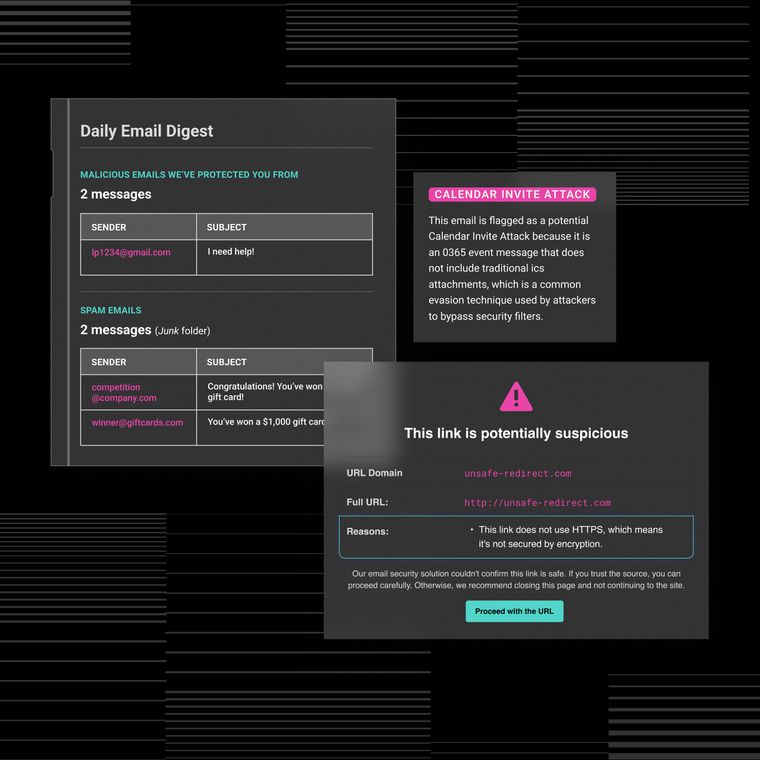3 Microsoft 365 Attacks That Expose Hidden Security Posture Gaps
Recent Microsoft 365 attacks expose configuration weaknesses behind cloud email breaches and reveal how posture management can prevent them.
October 22, 2025
/
3 min read

Attackers are increasingly breaching Microsoft 365 through configuration blind spots rather than malware-based intrusions. By exploiting posture weaknesses such as long-lived tokens, legacy authentication, and insecure session policies, they’re able to bypass multi-factor authentication (MFA), hijack accounts, and move laterally inside trusted environments.
Unlike software vulnerabilities or zero-days, these misconfigurations quietly accumulate over time, creating subtle openings in the cloud environment that traditional security solutions often miss. Recent threat intelligence shows that such posture-driven exposures are among the most common entry points in Microsoft 365 compromises. The good news is that with continuous monitoring and guided remediation, these gaps are also the easiest to close.
The following real-world examples illustrate how threat actors exploit posture misconfigurations in Microsoft 365 and how Abnormal Security Posture Management (SPM) identifies and remediates them before a serious breach can occur.
1. Gamma App Phishing Kit and Long-Lived Tokens
The Threat
A phishing campaign leveraged the Gamma App document generation platform to distribute malicious financial documents that appeared legitimate and passed standard authentication and hosting checks. When users opened the documents, attackers captured session tokens via the Sneaky 2FA Phishing Framework and maintained access to internal company systems even after MFA verification.
The Posture Gap
Many organizations retain default token lifetimes and lack strong reauthentication policies, leaving sessions active far longer than necessary.
This internal configuration weakness extends legitimate user sessions, giving threat actors prolonged access once a token is compromised.
How SPM Helps
SPM continuously scans for risky session configurations and weak reauthentication settings. It also offers guided remediation steps such as enabling Continuous Access Evaluation and shortening session token lifetimes. Tightening these posture settings minimizes the risk of compromise by reducing the potential window of exposure from days to hours.
2. Legacy Authentication Abuse
The Threat
Attackers leveraged the BAV2ROPC legacy protocol, which does not enforce MFA, to log in with stolen credentials. After gaining access, they were able to launch a large-scale spam bombing campaign from the compromised account to lay the groundwork for additional social engineering attacks designed to overwhelm users and hinder SOC response.
The Posture Gap
Many organizations leave legacy protocols enabled for compatibility. Unfortunately, these protocols bypass Conditional Access and MFA entirely, creating dangerous posture gaps.
How SPM Helps
SPM detects where legacy authentication is still active, prioritizes it as a high-risk misconfiguration, and provides step-by-step remediation to disable it. Eliminating this posture weakness blocks one of the most common account takeover methods in Microsoft 365.
3. Phishing Through Docusign and Token Replay
The Threat
Attackers distributed documents through Docusign that linked to a phishing page mimicking the Microsoft 365 login portal. Because the page was hosted on a legitimate Docusign domain and protected by a Cloudflare CAPTCHA, it appeared authentic and passed standard security checks.
When users entered their credentials and completed MFA, the phishing site captured valid session tokens, allowing threat actors to bypass authentication and maintain persistent access. Such access enabled them to impersonate users, move laterally, and exfiltrate data across connected cloud apps.
The Posture Gap
Stolen session tokens often remain valid across devices and sessions, enabling attackers to impersonate users long after the initial compromise.
This replay risk arises when Microsoft 365 lacks device binding or anomaly-detection controls that would invalidate tokens reused from new locations or devices.
How SPM Helps
SPM flags missing token protection policies and weak anomaly-detection controls. It provides remediation such as enabling token binding, which cryptographically ties tokens to devices, and monitoring for post-authentication anomalies like impossible travel. These posture improvements render stolen tokens useless outside the trusted device.
Why Microsoft 365 Posture Management Requires Autonomous Solutions
Each of these attacks succeeded not because defenses failed at the perimeter, but because internal Microsoft 365 settings were misconfigured or left unchecked. Hidden misconfigurations such as weak session lifetimes, legacy authentication, and token replay are the posture gaps threat actors rely on.
To prevent breaches, Security Posture Management continuously (and autonomously) audits Microsoft 365 against best practices and real-world attacker tactics. By surfacing risky configurations and guiding remediation, it ensures critical controls like MFA and Conditional Access function as intended.
As threat actors increasingly leverage identity and configuration abuse for account takeover, posture visibility has become essential. With Security Posture Management, organizations can verify that their defenses work as designed, detecting and resolving misconfigurations before they turn into yet another cautionary tale.
Robust Microsoft 365 Posture Starts Here
Misconfigurations are not minor oversights. They are the hidden weak links that make Microsoft 365 the easiest target in your security stack, and one of the top priorities to consider when strengthening your defenses.
Discover how Abnormal Security Posture Management identifies configuration gaps and strengthens your cloud email security posture. Schedule a demo today.
Related Posts
Get the Latest Email Security Insights
Subscribe to our newsletter to receive updates on the latest attacks and new trends in the email threat landscape.


